Text
Daily reminder that we do not actually live in a dystopian movie put the apocalypse down and back away slowly. You know when your cleaning a room and you pull everything out of it's draws to sort through it and you're like "what the fuck have I done I'm never going to be able to tidy all of this" I think that's the stage we're at in the world. Thanks to social media we've pulled out all the messed up shit from the cupboards of the world, it was always there but now we can see it and we're going to have to sort it all out we made this mess and we can fix it. Falling to the floor sobbing will not clean a crusty room. A group of people working systematically (preferably with music in the background) will.
31K notes
·
View notes
Text
SiliNOT! Testing and Review
Since I run a lot of casting workshops, I've had several people in the costuming/maker community ask me my opinion on SiliNOT!, a relatively new product advertised as a budget- and eco-friendly moldmaking alternative to silicone, urethane, and other single-use materials.
I finally bought a couple of bottles to play with, so I did a test project. My experience and findings are below! (It's not a recipe blog, but if you want to skip the play-by-play and get to the TL;DR, it's under the big "In Summary" header near the bottom.)

First, if you aren't familiar with this material, SiliNOT! is a remeltable, reusable medium for making molds. Though its exact ingredients are not disclosed, it purports to nontoxic, food-safe, and compostable. It melts in a household microwave or double boiler and solidifies at room temperature (or in a refrigerator/freezer for faster results). The website is https://silinot.com/.
(I am not an affiliate, and have no connection to this company apart from having made one retail purchase from them. I just have a lot of casting experience and like trying out new products.)
The Positive Original
I’m still in the middle of a Vincent Valentine build, so I decided to test the SiliNOT! on his custom buttons. My original is a stack of various nonporous materials: an antique (probably Bakelite) coat button, an epoxy resin dome I cast using a mold I already had in my library, and some engraved Worbla’s Pearly Art for the raised detail. The button shanks won’t be added until the final casting, so the original can be mounted flat for the moldmaking process.
Sample Worbla on the left; completed button stack on the right:
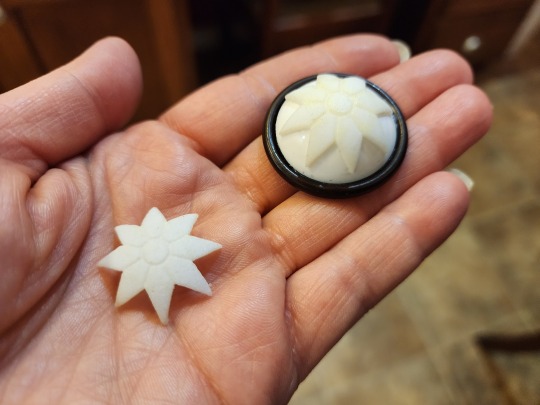
The Mold
I built the mold container the same way I do for silicone pours, with the flat back of the button fixed to a styrene plate and a cylinder (actually a small paper cup with the bottom cut off) surrounding it for the walls. The lip of the cup is sealed all the way around with Monster Clay to prevent leaks.
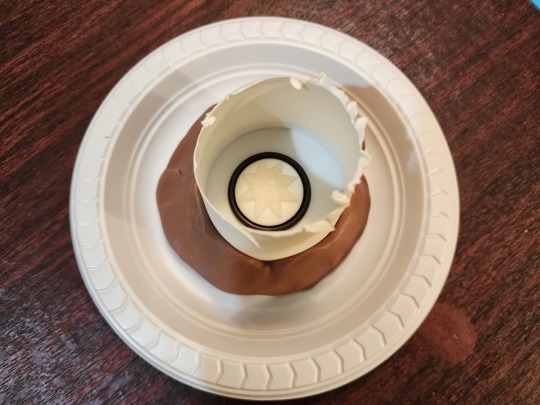
Heating and Pouring
The SiliNOT! didn’t take long at all to heat up; I did maybe four or five 20-second bursts before it was completely fluid. The bottle does get rather warm, so hand protection isn’t a bad idea. If you have heat-resistant gloves, you can use those; I was working in my kitchen (yay for nontoxic stuff!), so I just grabbed an oven mitt with a silicone grip.
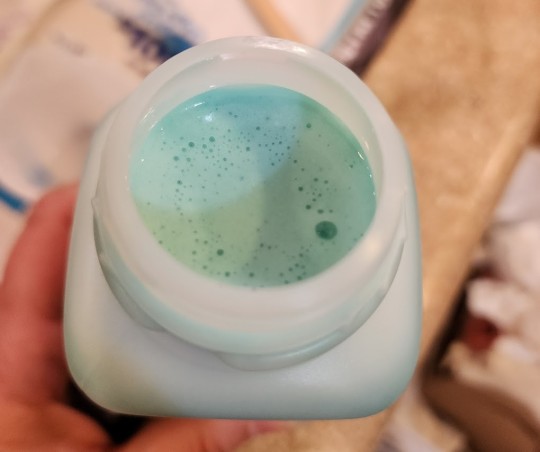
The melted SiliNOT! looks a bit like Luke Skywalker’s blue milk. It’s about the consistency of a yogurt smoothie and likes to pour in a thicker stream compared to silicone. While silicone can be stretched into a thin ribbon for delicate pours or chemically thinned with solvent for really tricky jobs, SiliNOT!'s viscosity is dependent on temperature and never seems to get quite as thin as silicone.
I’d automatically made my mold compact to conserve material (not really a concern with a reusable moldmaking material like SiliNOT!, but after using silicone for more than a decade, I’ve trained myself to be as efficient as possible), so the walls of my mold container were only about half or three quarters of an inch from my object. Because the target was so narrow, I found it difficult to accurately fill from the lowest area of the mold with the SiliNOT! The heavier pour also means more air can get trapped in or under the material.
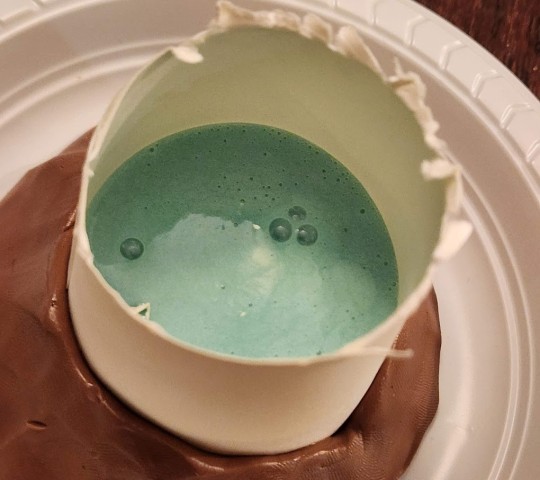
Bubbles are one of the areas in which SiliNOT! is decidedly inferior to silicone. SiliNOT! has higher viscosity, so bubbles don’t want to rise to the surface without vigorous tapping, which can distort the mold edges or affect leveling depending on your mold container. The bubbles that do make their way to the surface are difficult to pop, even when poked with a sharp implement. Heat gun degassing doesn’t have much effect.
Since the bubble surface cools and skins over quickly, I actually had to use a tool and scoop some large bubbles completely out of the mold to allow the surface to level. Critically, the SiliNOT! is opaque, so you can’t spot bubbles clinging to the surface of your original. (This is why my first mold was a reject, and I had to repour. More on that below.)
Hardening
Once the surface had set, I carefully moved the mold into the refrigerator to cool faster. Here’s another area where some types of silicone can have an advantage: I typically use fast-curing Smooth-On products (because I always have random quantities left to use up after our casting workshops), so I rarely have to wait more than half an hour for a silicone mold to cure, regardless of its size or mass.
The SiliNOT! has to chill completely before handling, though, and discharging that amount of heat requires a fair amount of time even in a cool environment. My mold was pretty small, maybe 2 1/2” wide by 1” deep, and it still took around 40 minutes to cool completely. A larger, deeper mold could hold considerably more energy in the center, and might have to be left in the freezer for a couple of hours before use.
Demolding the Original
When the mold was completely chilled, I removed it from the refrigerator and popped it off the plastic plate I’d used for the base of the mold. The texture was very different from what I’d expected: Unlike other meltable materials (Monster Clay, et al.) that have a firm surface when cool, the SiliNOT! remains tacky, which means it promptly collects any debris that crosses its path. In my case, this meant I had to pick dog hair off the surface throughout the casting process (and I don’t want to think about what would happen if glitter had contaminated the work space).

I’d used a paper cup for my mold walls, which usually works fine with fast-curing silicone. But the SiliNOT! must have a high oil content, because the cup absorbed some of it:
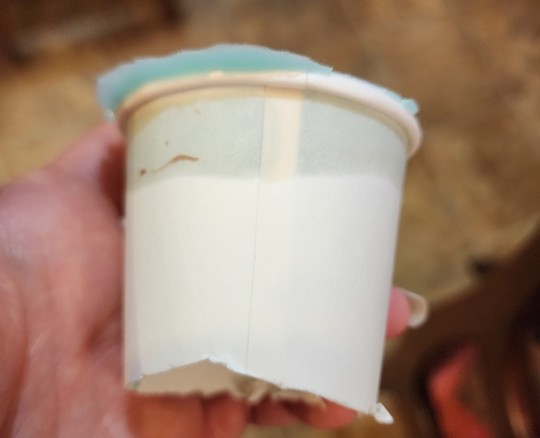
Lesson learned; use only nonporous containers with this stuff.
The SiliNOT!! really wanted to cling to the edges of my original, so I had to go slow at first to avoid tearing the thin flanges of the mold off. However, it did demold nicely from the smooth surfaces, and preserved texture very well. You can see the Worbla pebbling and the engraving channels clearly in the mold (as well as some dust and dog hair, because I made the mistake of setting it down briefly):

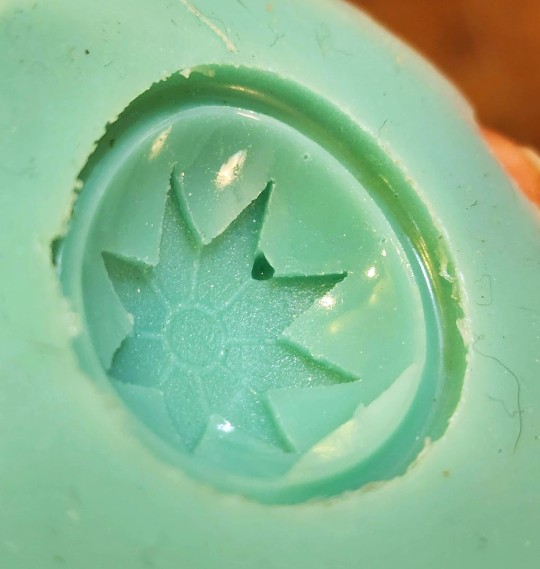
Unfortunately, as you can see, a large bubble had stuck to my original and created a pit in the mold, so I decided to do a second mold pour. I figured I’d tear up the failed mold and put the pieces back in the bottle to remelt… and discovered I couldn’t. The mold would stretch and twist, but not tear. It also seemed to return to its original shape relatively faithfully. Here’s a video of me manhandling the mold:
As you can see, the SiliNOT! has much better stretch and recovery than many silicone products (there are silicones that stretch well -- some of the Dragon Skin products come to mind -- but they’re not typically marketed for moldmaking). This means it’s likely well suited to casting objects with moderate undercuts or oddly-shaped bits that need the mold to stretch during demolding.
You can cut the SiliNOT! easily with scissors, which is the recommended method for getting it back in the bottle when you’re ready to remelt.
Take Two
Using what I’d learned from the first pour, I did the second one inside a hard plastic ramekin. This gave me a bit more room to pour into the floor of the mold, reducing the bubble risk, and also eliminated the porous paper cup that had absorbed oil. I still had the issue with bubbles that didn’t want to pop, but there were fewer of them this time.
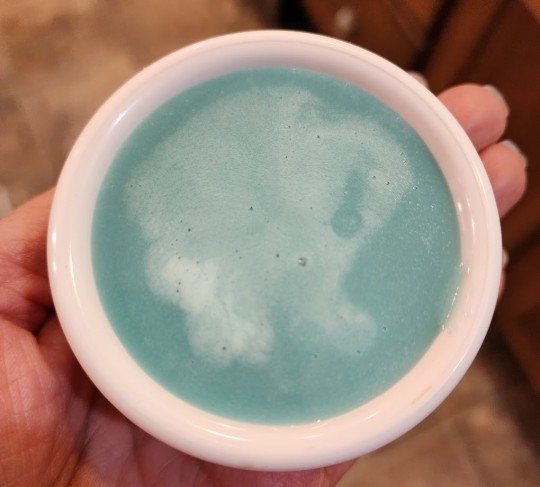
The ramekin made for a much cleaner mold, buuuuut there was ANOTHER BUBBLE right in the middle of the design. >.<
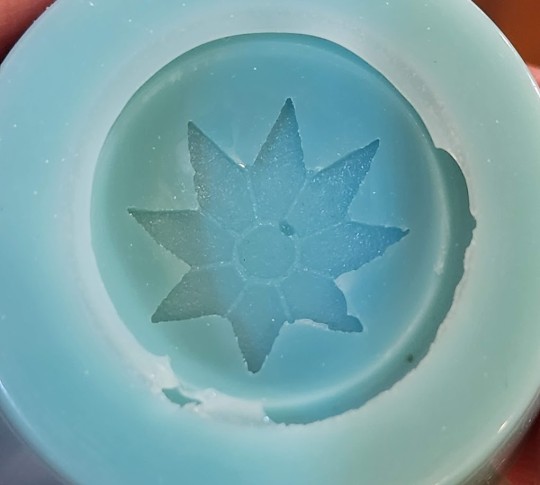
Take Three
Lather, rinse, repeat. Or in this case, melt, pour, chill.
This time I heated the SiliNOT! as much as I dared and did the absolute slowest, narrowest pour I could manage, giving the air extra time to escape as the mold was filled from the bottom. The risk with stringing out the pour like this is that in a thinner stream, the heat escapes faster, leading to uneven viscosity as the liquid fills the mold. I don’t think that’s a major problem for this particular piece, but it’s something to pay attention to as regards leveling and degassing, especially for larger molds that will take longer to fill.
The result of pour three:
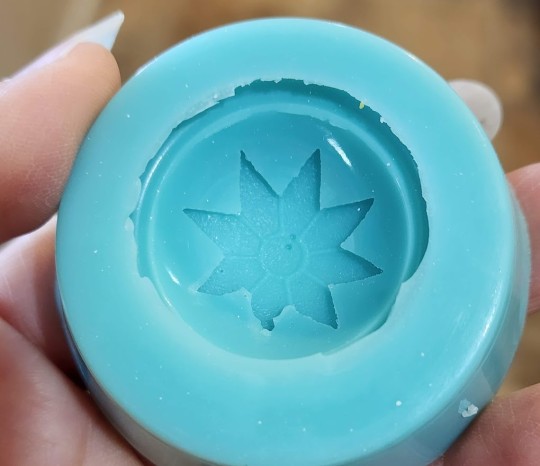
/siiiiigh/ Well, at least the bubbles are smaller, this time. They may not show up enough to matter in the final cast. I’ll give it a try.
Casting
I had leftover workshop resin that was getting on toward the end of its shelf life, so I used Smooth-On Smooth-Cast 300 for my initial resin trial. It’s an opaque white resin with about a 10-minute cure time (the fast turnaround is why we use it for workshops).
Before pouring, I had to do a little mold cleanup where the SiliNOT! had managed to sneak under the edge of the Worbla (I think I’d loosened the corner of the star from prying it out of so many molds), but since the SiliNOT! stretches so well, it was pretty easy to invert it to get little scissors down into the bottom of the depression.
For the first cast, I didn’t use anything but the resin in order to get a baseline. Ideally I’d like to cold cast or dye the resin so I don’t have to worry about paint chipping, but since I’m doing a trial here (and need multiple buttons anyway) I figured some plain white extras wouldn’t hurt.
So, my first cast…

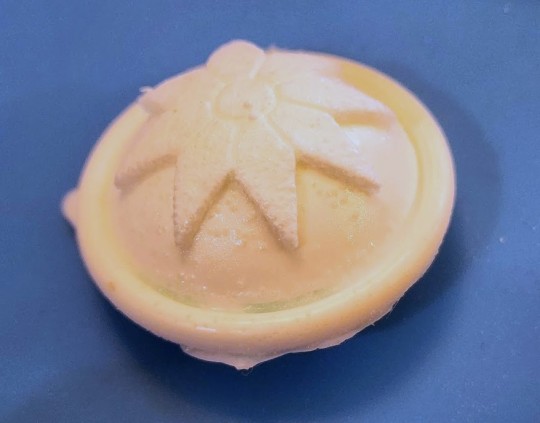
…smacked into a big problem, which I probably should have seen coming: The resin I’m using is a fast cure formula, which means it discharges a fair amount of heat as it's going through that rapid chemical reaction -- enough heat to melt the SiliNOT!, as it turned out. When I tried to demold it (after giving it a few extra minutes beyond label time to be sure it was done), the surface of the mold had melted to the resin and even embedded itself in a few places. It’s difficult to see the resin detail in the photos (my camera went into white balance panic mode with all the shades of white and blue), but you can see how pitted the formerly-smooth mold surface is.
In fairness to the SiliNOT!, the bottle does say that you should put the mold in the freezer for half an hour before casting high-temperature materials. But I assumed high-temperature material was something like candle wax or melted chocolate, rather than ordinary resin. (And the mold had just come out of the refrigerator.)
So, on to pour FOUR of the SiliNOT! mold…
Take Four
NGL, this is getting a little old. >.<
Fourth mold definitely needed some cleanup around the edges, and there are still a couple of tiny bubbles I can’t seem to get rid of, but it’s good enough for a test. (I’m starting to despair of using these for actual production, given how many times I’ve had to redo the molds because of bubbles...)

Deep in the recesses of my basement, I found some transparent epoxy resin with a 24-hour cure time -- much slower and lower-temperature than the Smooth-Cast. Since it cures clear, I went ahead and mixed in some metallic powder pigment on the off chance that I get a usable button out of this one. I had excess resin after mixing, so I poured that into my first mold, which has a bubble in the design but is otherwise fine. Two test pieces are better than one, right?
Results
Here are the results of the slow-curing resin out of mold #4:
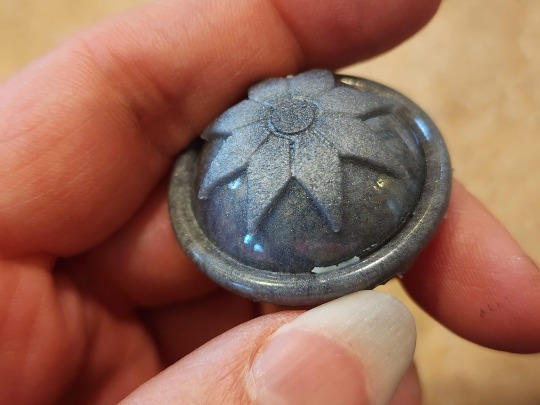
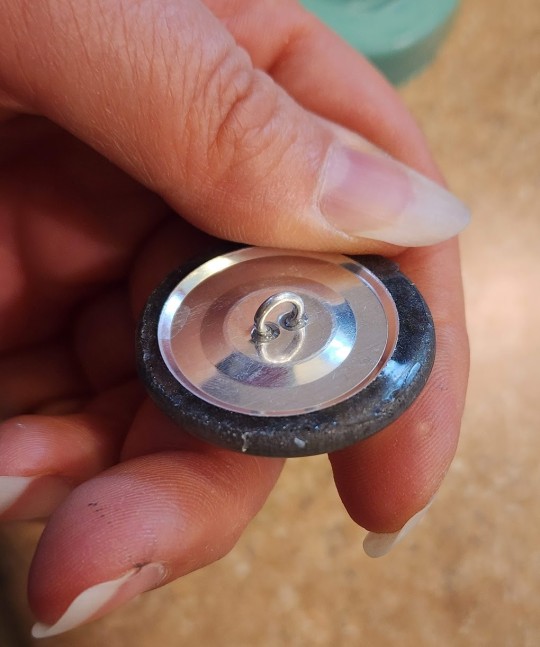
Finally, a (mostly) clean cast!
As you can see, the detail reproduction is excellent -- certainly on par with the pulls from the silicone mold I ended up making while waiting on this set to cure (purely for time reasons; I couldn’t afford five days to cast the buttons using slow-curing resin, and with a silicone mold and fast-curing resin I could get them all done within a couple of hours).
However, you can also see a few spots where bits of the SiliNOT! embedded themselves in the final cast. Part of that may be due to design flaw in the original; I didn’t want to glue anything permanently to the antique button, and that resulted in a tiny gap between the button and the resin hemisphere. Silicone has enough strength to resist tearing out in that kind of area, but apparently the SiliNOT! doesn’t. The bits of mold around the outer edge seem to have stuck just to be difficult, as there was no structural reason for those to have become embedded in the resin. This means the mold could be damaged by successive casts, reducing its usable life and accuracy.
Still, the mold definitely produced decent results for a first cast, and a different shape might not have had as much of a problem with tearing off mold parts. The slow-curing resin is a bit of a limitation, but not a unique one (I use this same epoxy resin for any glass-clear casts I do, and only use the Smooth-Cast 300 for opaque items or things I need very quickly). I don’t personally use UV resin, but I’d be curious to learn how it performs with the SiliNOT!
IN SUMMARY:
Here’s the TL;DR on SiliNOT!
Pros
Cost effectiveness. This is the most obvious advantage of SiliNOT! over silicone; it’s (theoretically) infinitely reusable, and even with natural attrition/inevitable contamination from use, you can likely get over a hundred pours out of a bottle. That's a lot cheaper per use than silicone.
Non-toxicity. SiliNOT! is touted as food contact-safe, so you don’t have to panic if you get it on your skin or kitchen counters. While platinum-cure silicone is also relatively harmless (some varieties are labeled for food or life casting), other common moldmaking materials such as tin-cure silicone or urethane are not. (NOTE: Since the company is very hush-hush about what actually makes up the SiliNOT! secret formula, I do not know if it might release any vapors or fumes that would be irritating or harmful to pet birds. In general, I advise not doing any kind of casting around birds.)
Eco-friendliness. This is the biggest draw for me personally: Given the number of casting workshops I run and all the things I sell commercially, I have constant guilt about the amount of waste I generate for creative projects. In most areas of life I’m an aggressive reduce/reuse/recycler and try to use organic materials instead of synthetics whenever possible, so a mold that’s reusable and compostable is very appealing.
Ease of use. It’s honestly pretty hard to mess this up -- just microwave according to the directions and pour. No measuring, no A/B mixture, no concerns about chemical contamination from latex or sulfur, etc.
Shelf life. Unlike silicones, which have a shelf life of anywhere from six months to three years depending on storage conditions, the SiliNOT! purports to be shelf-stable. It's compostable, so don’t bury it in your yard, but otherwise it appears that it could be kept on hand for years.
Cons
Bubbles. Honestly the most irritating thing about this stuff for me. I’m used to being able to see bubbles forming as I pour, tap them to the surface, and remove them. The fact that I poured four molds of the same object and never once got one without bubbles is super irritating.
Stickiness. I’m not a big fan of the tacky surface texture, and while I haven’t done any cold casting yet, I can imagine that it would be very difficult to clean out any pigment or mica powder that got where you didn’t want it. I probably wouldn’t use this for any kind of cold casting that required isolated colored areas or changing colors between casts.
Set time. The SiliNOT! may take longer to cool than a fast silicone would to cure when dealing with larger molds, so it’s not ideal for projects with a really tight turnaround. (But cosplayers would never be casting something the night before a con, right? We always plan ahead and never, ever procrastinate!)
Library life. The SiliNOT! may or may not structurally degrade over time the way urethane, latex, and tin cure silicones do, but I noticed even in my very limited casts that it was prone to having tiny bits of the mold (particularly at edges) stick and pull off. While I keep most of my platinum silicone molds for years and reuse them, I don’t feel that the SiliNOT! molds would hold up to repeated casting, and they’re far more sensitive to ambient temperature, so they’re probably best used for short term only. (I also wonder about the possibility of oil leaching out in long-term storage.)
Comparative Ranking
Ranking it against other mold-making materials, I’d place SiliNOT! below platinum-cure silicone in terms of performance, but maybe somewhere in the neighborhood of urethane and tin-cure silicone. It's definitely superior to latex. (Though to be honest, I'd rank Play-Doh above latex. I hate working with that stuff.)
Factoring in cost and environmental impact, it beats out urethane and tin-cure silicone. I'm still not sure if I'd rank it above platinum-cure silicone, though... Silicone costs much more and isn't eco-friendly, but the performance and lifespan is significantly better, so it still makes more sense for some projects.
Alginate is another type of material entirely, but in some ways SiliNOT! is comparable to it -- both are more cost-effective than silicone, both are biodegradable, both are skin safe, and both have long shelf lives. But SiliNOT! is easier to use for beginners than alginate, which has to be mixed to the right consistency and has an extremely short lifespan once poured.
Overall, I would recommend SiliNOT! for:
People who want accurate, non-shrinking molds but don’t have the budget for platinum-cure silicone
People who are committed to eliminating waste from single-use materials, and are willing to trade off a little performance for a more eco-friendly material
Projects with smooth surfaces and no indentations/sharp edges/undercuts where bubbles might stick (e.g. cabochons; simple geometric forms)
Projects where you need only one or two casts of something, rather than many casts from the same mold
Casting oddly-shaped pieces around which the mold needs to stretch in order to demold
Use with slow-curing resins that do not generate much heat
I would NOT recommend SiliNOT! for:
Extremely complex or detailed pieces, or pieces with a lot of surface texture that bubbles might stick to
Two-part molds
Projects requiring many identical casts out of the same mold
Molds that you intend to add to your library for future or repeat casting
Use with fast-curing resins, melted wax, melted Monster Clay, or any other material that emits heat
Cold casting with precise color application
My Overall Opinion
It's... okay? I will almost certainly keep SiliNOT! in my toolkit for certain specific applications. It's MUCH cheaper over the long term, I love the idea of recycling mold material, and there are some projects for which it will likely perform very well (those listed in the above bullet points). I will also admit that three days of working with it does not constitute a comprehensive familiarity with the product, and it might be the sort of thing that you get better at working with after more practice. (Just learning how to eliminate bubbles would go a long way toward making me adopt this for more projects!)
However, I don't quite buy the "better than silicone" tagline. It's definitely more difficult to get a perfect result, and there are some projects for which platinum-cure silicone is always going to be more reliable (e.g. high-temperature casting, mass production, large-scale life casting).
For those looking for a recommendation of whether or not to buy, I'd say look at your project budget and the applications for which you're going to be making molds, and let those factors guide which mold material you go with. People doing some kinds of projects are likely going to find this a godsend, while those doing different projects would probably hate working with it.
31 notes
·
View notes
Text
#current is at 3.5 years#previous was at nearly 4 before it hit the point where the battery died after an hour but it still works#but I also have my HTC Magic (my first smartphone + second Android phone available anywhere) which is 15yo and also needs a new battery but
11K notes
·
View notes
Text
32K notes
·
View notes
Photo

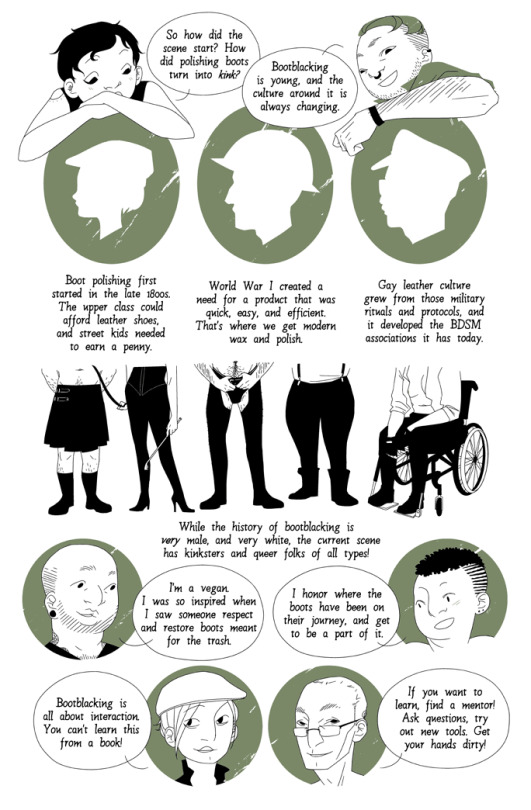


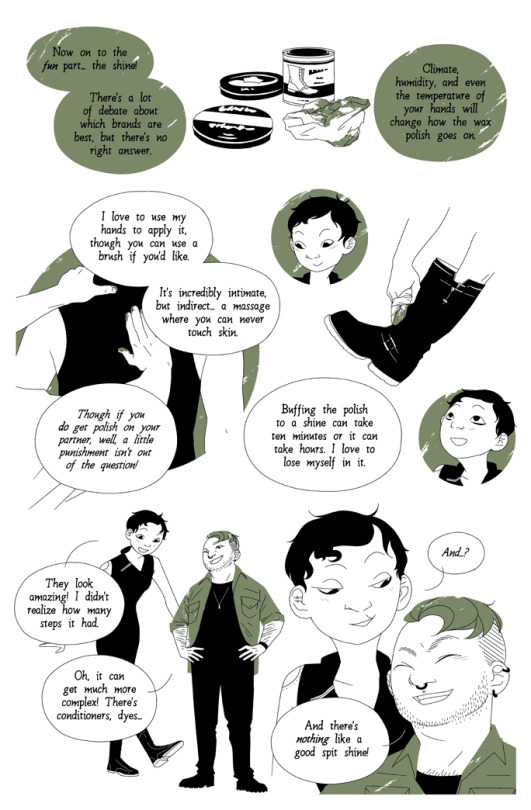
Hey! Here’s a little five page comic I did about boot blacking and kink. I had a lot of fun with it, and talked to some really cool people.
7K notes
·
View notes
Text
43K notes
·
View notes
Text
#The rest of 'Justice in the Dark' lmao#you'd think I'd say 'Winner is King' because SPL Is my favorite novel#but I am dreading how they censor changgu and the kind of fans that'll bring in#the fact that it's schrodinger's incest is the point okay
235 notes
·
View notes
Text
I recently encountered a real life adult human who had no idea what the Evil Overlord list was. Naturally I was delighted to do my part for this member of the lucky 10,000. But just in case there are more people living an Evil-Overlord-List-less life, here it is:
The Top 100 Things I'd Do If I Ever Became An Evil Overlord
1. My Legions of Terror will have helmets with clear plexiglass visors, not face-concealing ones.
2. My ventilation ducts will be too small to crawl through.
3. My noble half-brother whose throne I usurped will be killed, not kept anonymously imprisoned in a forgotten cell of my dungeon.
4. Shooting is not too good for my enemies.
5. The artifact which is the source of my power will not be kept on the Mountain of Despair beyond the River of Fire guarded by the Dragons of Eternity. It will be in my safe-deposit box. The same applies to the object which is my one weakness.
6. I will not gloat over my enemies' predicament before killing them.
7. When I've captured my adversary and he says, "Look, before you kill me, will you at least tell me what this is all about?" I'll say, "No." and shoot him. No, on second thought I'll shoot him then say "No."
8. After I kidnap the beautiful princess, we will be married immediately in a quiet civil ceremony, not a lavish spectacle in three weeks' time during which the final phase of my plan will be carried out.
9. I will not include a self-destruct mechanism unless absolutely necessary. If it is necessary, it will not be a large red button labelled "Danger: Do Not Push". The big red button marked "Do Not Push" will instead trigger a spray of bullets on anyone stupid enough to disregard it. Similarly, the ON/OFF switch will not clearly be labelled as such.
10. ….
There’s (much) more:
35 notes
·
View notes
Text
This is something I'm seeing more and more on AO3 that I'd never seen when I first got into fandom stuff, so I wanted to find out how you all feel about it.
What are your thoughts about seeing posted fanfiction that isn't commissioned, where the creator says that they have never read/watched the source material? For example, someone putting out a fanfic for a show they've never watched that includes the tag Author Has Never Seen Suchandsuch.
#I am both 'you do you' and also 'I have negative interest in reading this because it will probably be full of bad OOC fanon tropes'#also to me there is a diff between 'hasn't consumed ALL of the canon' and 'hasn't consumed ANY of the canon' and I am only talking about th
3K notes
·
View notes
Text
Additional info - all hospitals run as nonprofits (which is... a lot of them) are required to have some version of this policy, which is known as 'charity care'. Many of them make it hard to fight, but there are organizations dedicated to tracking this info and helping people apply for it. https://dollarfor.org/ is the big one I am aware of, and from their docs "On average in 2024, households under 212% of the Federal Poverty Level will qualify for free care, and families under 311% will qualify for discounted care. These averages are derived from Dollar For’s national database of hospital financial assistance policies." (federal poverty guidelines being $15k a year for a one-person household or $20k for a two-person household)
Also shout-out to the podcast An Arm and a Leg (https://armandalegshow.com/) for giving me this info and other solid info about US healthcare.
I feel like I should make a post about this because it’s not something that’s very well-known, and that Americans in particular may need to know about given the uncertain state of our healthcare system at the moment. I’ve wanted to write this out for a while, It’s kind of a long post, so sorry about that!
If you have an emergency and have to go to the hospital, you’ll owe the hospital a lot of money.
(I got into a car wreck and broke my ankle and my arm. My hospital bill was around $20,000)
You’ll also owe the ambulance provider, if you need one.
(My ambulance bill was about $800)
You may get separate bills from the anesthesiologist or surgeon.
(My anesthesiologist bill was $1,700)
You may need follow-up appointments.
(My orthopedic surgeon billed me for the appointments and his surgery together and it was about $1,000)
You’ve also got to pay for medical equipment you need afterward, like crutches or a walking boot.
(Mine cost about $75)
Altogether, I ended up with almost $24,000 in medical debt from one car accident. That’s a really scary number for someone like me who makes $10/hr at a 12 hour a week job.
I got my debt down to $1075 by making some phone calls and submitting some paperwork.
The first thing I did was contact the hospital. They don’t make it easy to find, but many hospitals (perhaps most hospitals?) have financial assistance programs for people who can’t afford medical bills. I don’t make a lot of money, and I have bills to pay, so they were able to help me.
I called the billing department and asked if they had any assistance programs for low income people who can’t pay their bills. I had to call multiple times, and I got transferred in circles by people who didn’t know what I was talking about. Finally, I got an appointment with someone in “Eligibility Services” (I don’t know what other hospitals call it, if it’s something different). I had to bring my pay stubs and copies of all of my bills. When I got to the hospital for the appointment, nobody knew what I was talking about so I had to wander a little to find where I needed to go. I spoke with the guy in Eligibility Services, and I waited for a decision on how much of the bill they would forgive. A month later, I got a call telling me it was totally forgiven.
I did the same thing for my ambulance bill and my anesthesiologist, but the process was a LOT easier. I just had to mail some paperwork and it was totally forgiven.
I didn’t bother with the medical equipment suppliers, since the bills came from separate companies and I didn’t feel like going through the process twice for $75. I was assured at the hospital that they had similar programs for debt forgiveness, so I could have probably avoided paying that too.
The only thing I couldn’t get taken care of was the surgeon/follow-up appointment cost, but they were able to put me on a no-interest payment plan.
Medical debt is scary because it’s something that can come from stuff that’s already really scary. I didn’t need the burden of $24,000 in debt on top of trying to get around on a crutch with a broken arm (it’s not easy, believe me!).. but I can’t imagine what it would be like with a bigger debt or a more severe medical emergency.
I see lots of people in even worse trouble than I was in, both financially and medically. Please know that there are options for you when that GoFundMe doesn’t do enough. Even if your income is higher than mine, it’s worth a shot even for partial debt forgiveness.
221K notes
·
View notes
Text
OMG the backstory behind the whole boop thing is amazing.
31K notes
·
View notes
Text
I'm wondering what the norm is about working on your birthday is. Plz reblog for more responses.
#firmly of the belief that everyone should get their birthday as PTO#which I think was a policy during a previous set of corporate owners but it's hard to keep track#I took my birthday off this year and spent it playing video games and getting ramen delivered
6K notes
·
View notes
Text
but yeah i really dont know what Normal Jobs have for paperwork because my gay ass only knows write code, open pull request, torture robot, design doc, and lie
#no lies detected#some of us get really into Building Shit in the one hour we are not mindmelding with a computer#but we still suck at paperwork
604 notes
·
View notes
Text
this is so funny
"but uh when we advocated for indigenous sovereignty we thought you guys were just going to make a big park or something"
"fuck you. ultradense housing that bypasses your stupid zoning rules"
#as someone who lived in a shitty sketchy basement sublet in Kits with an awful landlord for a summer#the nimbys in Kits can die mad about it
17K notes
·
View notes
Text
Textile folks! If you're ever in or near Germany (or if you live there but haven't visited it yet), make time for the Chemnitz Industrial Museum! You won't regret it.
Chemnitz in particular and Saxony more broadly has been (and still is) a major center for textile production from the industrial revolution onwards. This museum includes an entire section of spinning, knitting, weaving, and malimo equipment which all still work and if you show up for the guided tour you get to see them in action!
The tour was only in German, but if you have any grasp of the basic principles of spinning and weaving and the google translate app in transcribe mode, you can get through fine. (I also got to watch a steam engine work!)




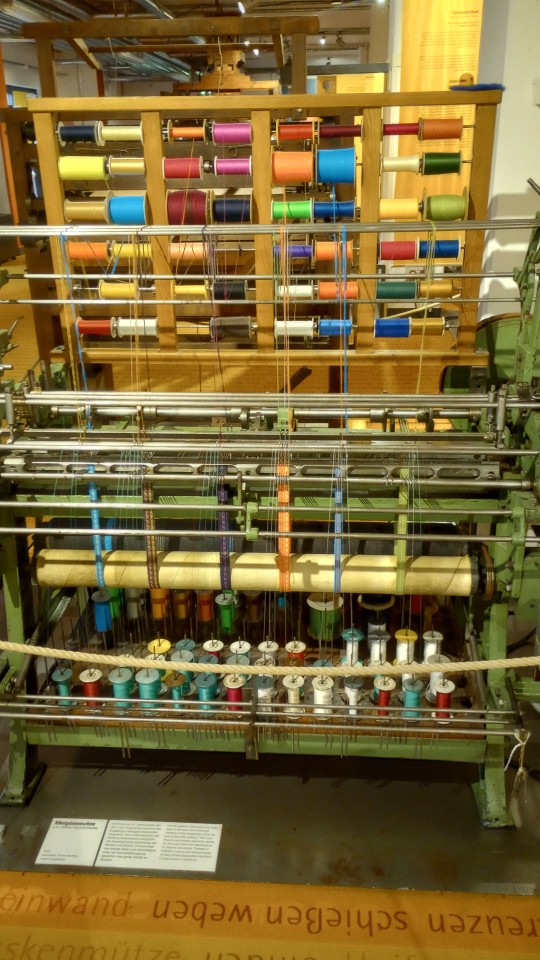
Okay, assuming tumblr doesn't mess up my pic order again...
Top left: hand powered Crompton Mule
Top right: powered continuous-band weaving machine. No seam on the finished piece!
Middle: powered malimo machine, a type of fabric I never knew existed
Bottom left: a napping machine with original teasel heads! These were eventually replaced with metal heads, but this is how the machines were originally built.
Bottom right: a powered trim making machine. It looked somewhere in the middle of a venn diagram of knitting, sewing, and weaving. Wild.
Did you know that today BASALT (yes. the rock!!) Is spun and woven?!! I sure didn't!


Very brief summary: break rock into small pieces, melt rock, draw up threads of rock, coat with size, store on drums, weave.
I cannot cope. Mind blown. Milk? Sure. Glass? Sure. Carbon? Okay, cool. ROCK??
151 notes
·
View notes
Text
Gu Yun Week Day 3 - Fathers & Sons
As much as I would like to write some real fucked up changgu fic based on the idea of filial cannibalism, I have already written more this week than I think I did like, all of last year, so instead I'm just gonna thought-dump about Gu Yun and Gu Shen. Not really meta, as I don't think this is anything the text doesn't already cover, but just. Thoughts. Mostly that it's interesting that through most of the novel we only see Gu Shen through the distortion of the public's perception of him, or Gu Yun's memories, which are distorted in other ways. And neither of these are particularly kind to Gu Shen. In public opinion, he's a skilled military leader, but also absolutely heartless. To Gu Yun, he is the memory of childhood trauma, of one of the hardest periods in his life.
And then we get to the 'Gu Shen' extra. This is the first time we actually see Gu Shen first-hand, rather than filtered through another person. While the narrative presents the possibility that what we're seeing is a dream Gu Yun is having, I'd argue that the long sections without Gu Yun present and the 'present day' evidence of the box of toys means that Gu Yun's dream is just a transition device - we as readers are getting the full view of a memory that Gu Yun remembers just the tail end of as part of his dream. The first-hand view we get of Gu Shen is far more nuanced - he's still imposing in command, but also seems to love his wife deeply, and flirts with her with the same sort of charm Gu Yun later uses on Changgeng. And with Gu Yun, we see a man who has had access to zero parenting books and who is perhaps out of his depth with his troublemaker son, but who still cares and wants him to prosper.
And that view makes me think that the Black Iron camp incident was a trauma that affected more than just Gu Yun, even though he's the focal character. To Gu Shen and the First Princess, their hopes of their son having an easier, brighter life them are shattered. And I think that's what we see in the secondhand story in the Qingming extra - Gu Shen seems to be angry with Gu Yun, but it's an anger born of fear, that if he can't make Gu Yun stronger, the world would destroy him. And this is something that even Gu Yun acknowledges to himself in the 'Gu Shen' extra - that looking back on it from an adult's perspective, less clouded by his own feelings, he can understand why his father acted the way he did. And understanding isn't forgiveness, but it definitely gives their relationship more depth.
6 notes
·
View notes
